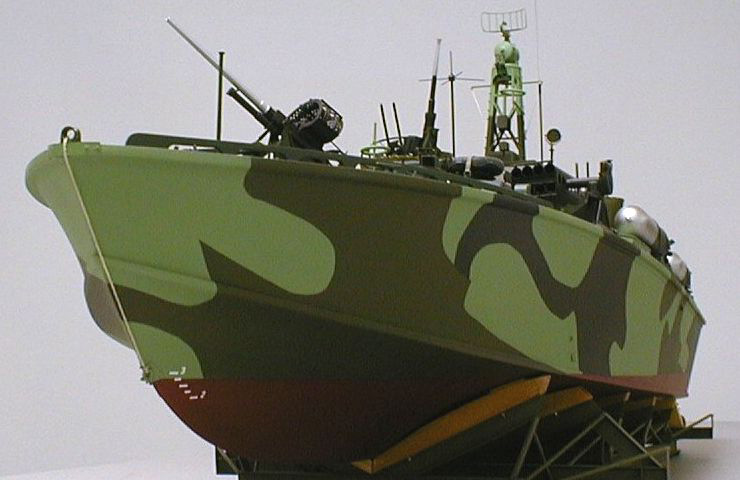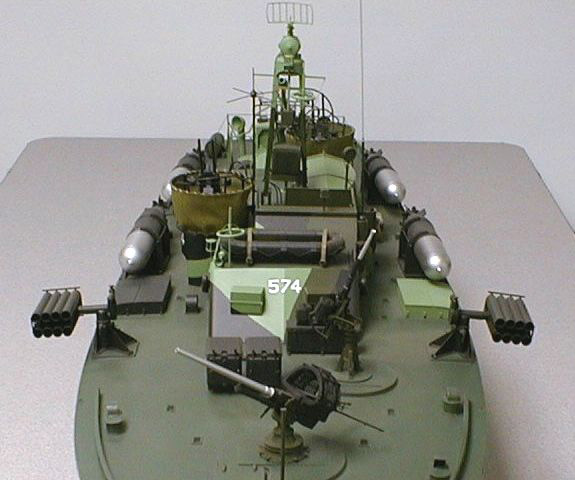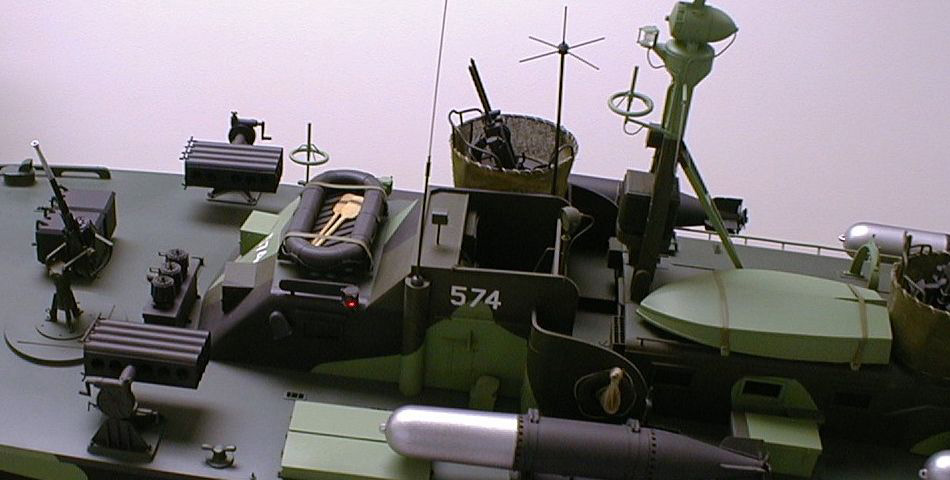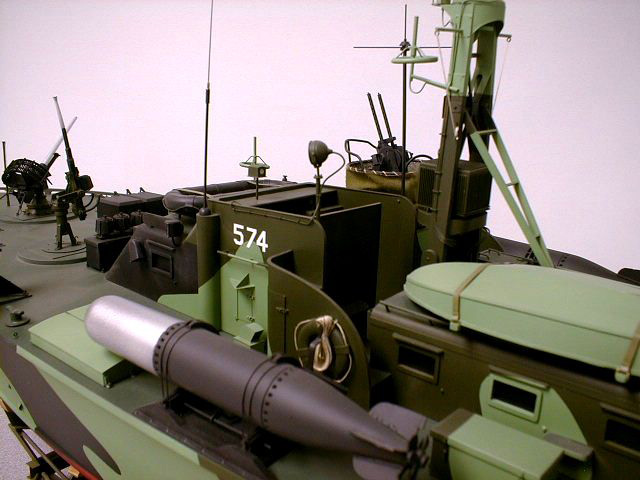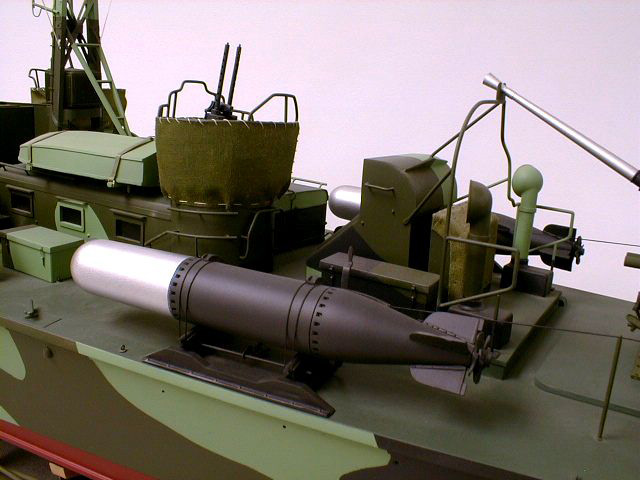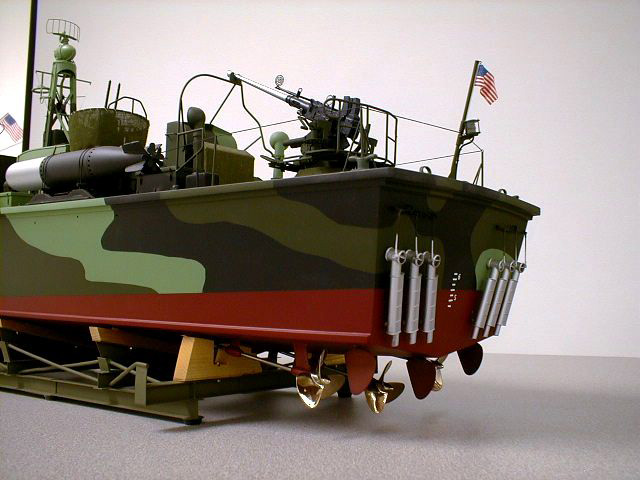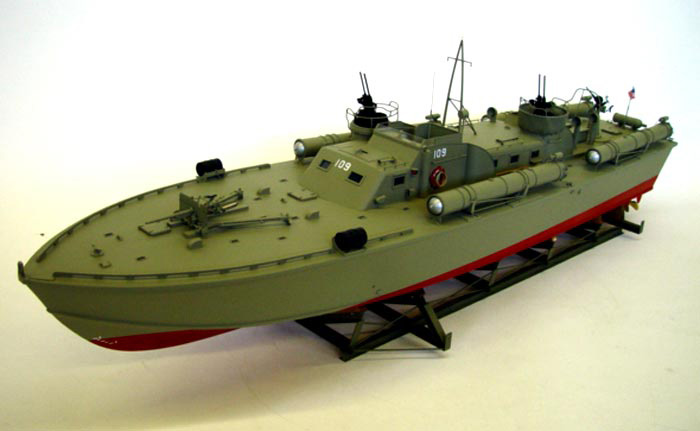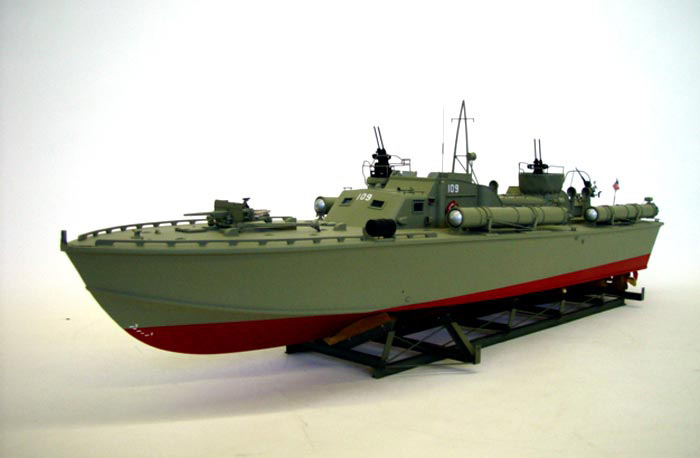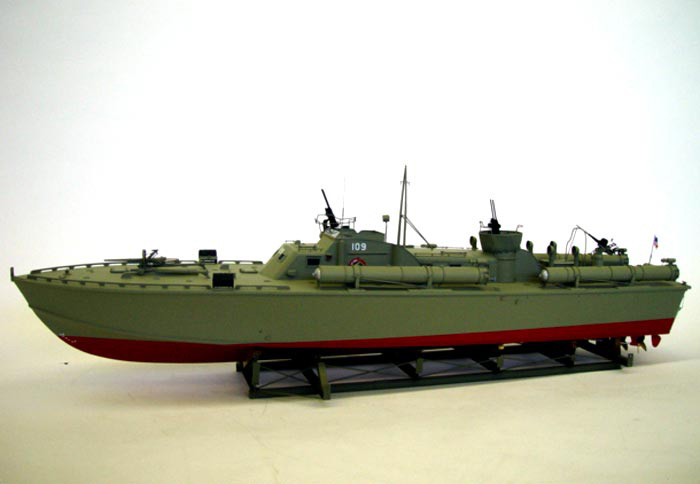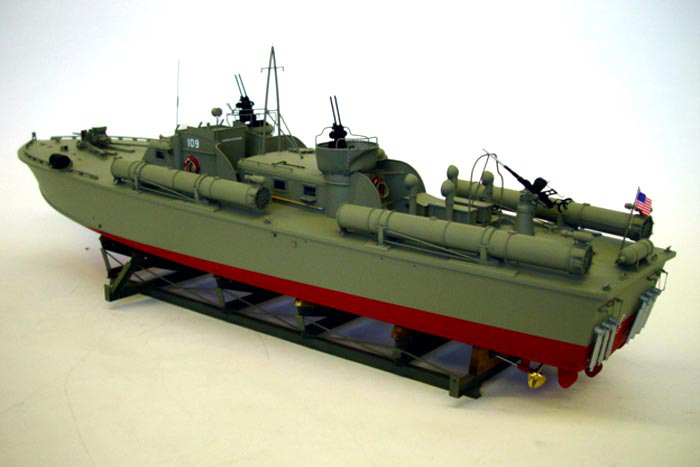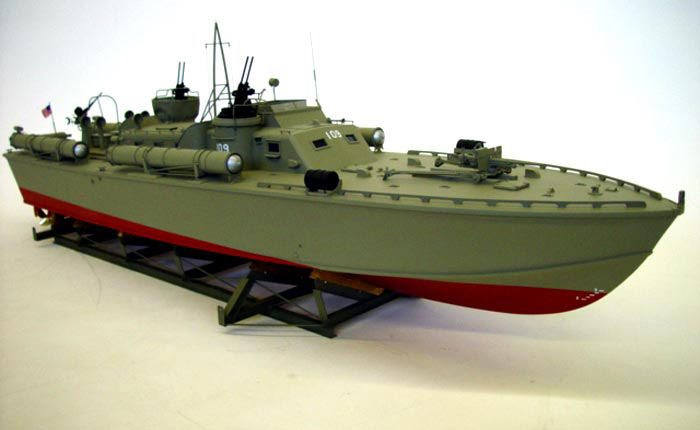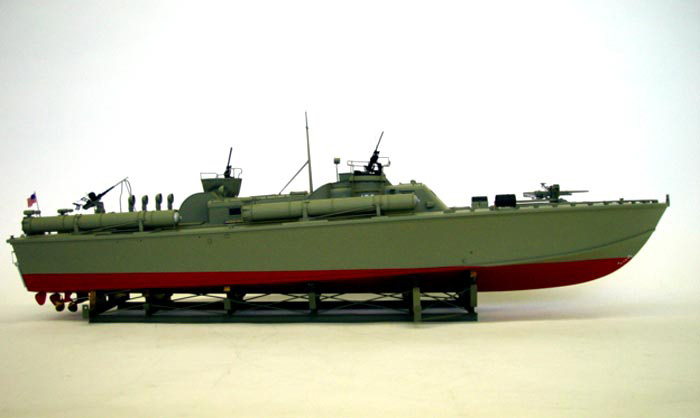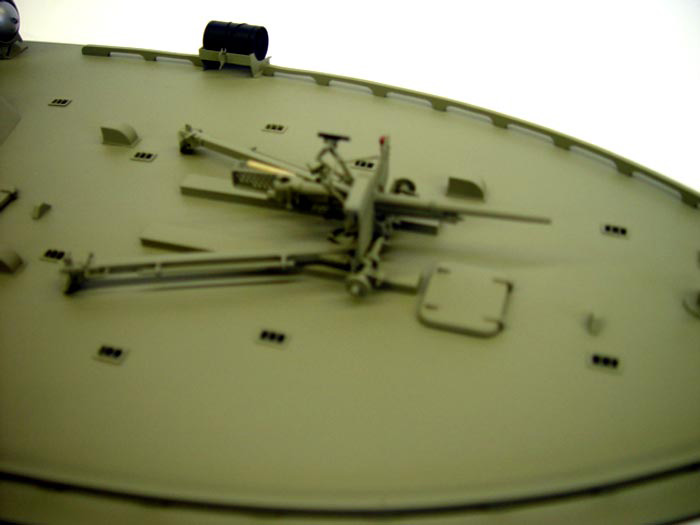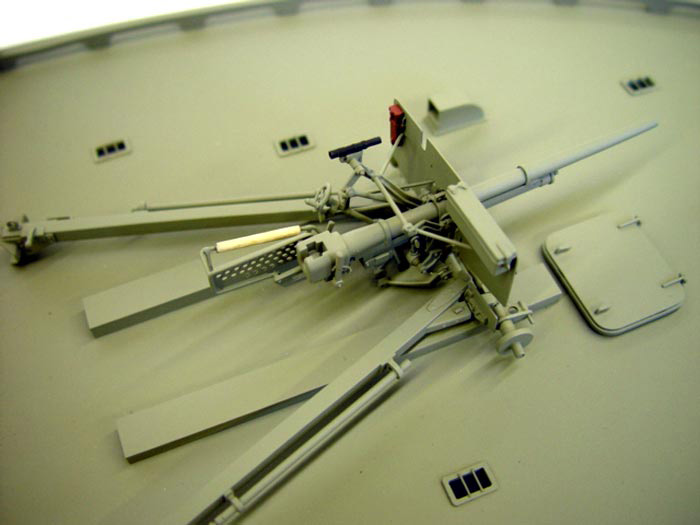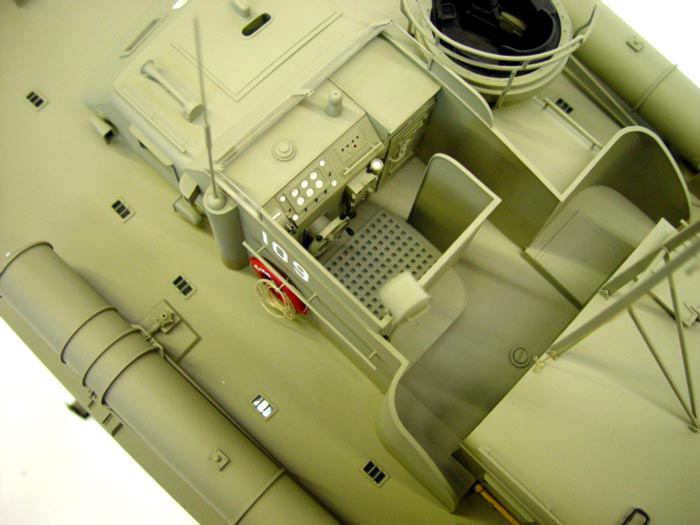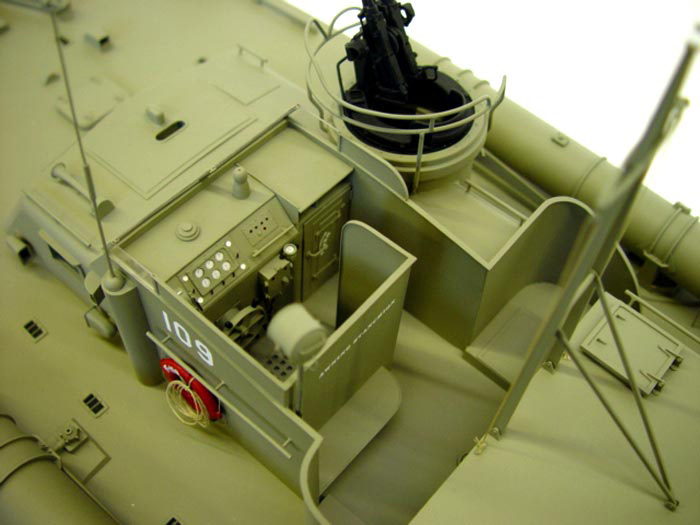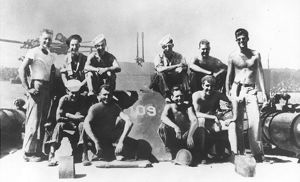PT Boat
Elco 80 Foot PT Boat – Camouflage
- Scale: 1:20
- Release: 1995
- Limited Edition: 25
- Model Size: 40”L x 12”W x 14”H
- Base Type: Black Walnut
- Base/Case Size: 48”L x 15”Wx 14”H
- Availability: Sold out
Elco 80 Foot PT Boat – Gray (not pictured)
- Scale: 1:24
- Release: 1995
- Limited Edition: 25
- Model Size: 40”L x 12”W x 14”H
- Base Type: Black Walnut
- Base/Case Size: 48”L x 15”Wx 18”H
- Availability: Sold out
Elco 80 Foot PT Boat – PT 109
- Scale: 1:20
- Release: 2002
- Limited Edition: 50
- Model Size: 40”L x 12”W x 14”H
- Base Type: Black Walnut
- Base/Case Size: 48”L x 15”Wx 18”H
- Availability: Sold out
Elco 80-foot PT Boat
The enemy called them “a monster that roars, flaps its wings, and fires torpedoes.” The American press called them “mosquito boats” and “expendables.” They were the motor torpedo boats of World War II – the PT boats.
In 1892, the Electric Launch Company (Elco) was founded to produce electric launches for the Chicago World’s Fair. In 1914, it introduced standardized construction with its 32-foot Cruisette, and then carved a niche for itself in the history of mass production by producing 550 110-foot patrol boats and minesweepers for the British Admiralty in a mere 488 days during World War I.
In 1937, the U.S. Navy saw the potential of using inexpensive high-speed wood patrol torpedo (PT) vessels for delivering torpedo attacks and conducting anti-submarine warfare. After it tested three (3) experimental boats, it published terms for a design competition and ordered eight (8) boats (PTs 1–8). But these were not wholly satisfactory, so experiments continued into 1939. By then, Elco (now a division of Electric Boat) had seen the possibility of leveraging its World War I experience. The designer and production manager from those days were still with the company when entering the motor torpedo boat market, and proposed a 70-foot boat that became PT 9. A stretched, interim 77-foot version suffered from hull strength and sea-keeping problems. But in July 1941, new plywood derbies were conducted with competitive designs from Higgins and Huckins. These tests yielded yet another set of requirements, and this time, production contracts were awarded to all three builders.
The Huckins design proved still too weak in service, but the 78-foot Higgins PT 71 was a good boat and the 80-foot Elco PT 103 proved to be the best of all – fast and dry with a smooth ride and good visibility for its crew … relatively speaking! It was fast enough to become airborne in even a moderate swell and, in rough weather, the pounding could throw everyone off their feet. Although Elco received its contract after the others, its boats entered squadron service first. They were built in two series at Elco’s Bayonne, New Jersey yard. The first consisted of PTs 103–196 and 314–167; the second included PTs 372–383, 486–563 and 565–622. They delivered classic torpedo attacks as well as attacks on shallow-draft barges with guns. Most served in the Pacific where many were lost (including PT 109, commanded by then Lieutenant John F. Kennedy), with two squadrons deployed to the English Channel and one to the Mediterranean.
Today, the Elco legacy lives on. Although the navy burned and scrapped almost its entire PT boat fleet immediately after the war, the modern-day Electric Launch Company is again producing electric pleasure boats in Highland, New York for a customer list that reads like a social register, much as it did more than 100 years ago.
About the Model…
PTs 565–624, built in the last year of the war, were the most highly developed Elcos, as much a gunboat as it was a torpedo boat. With a life raft on top of the charthouse and an 8-foot wherry on the day-room cabin, they also had the most interesting equipment, and thus, are the boats that Fine Art Models’ chose to build in a scale of 1:20 with exacting detail.
A limited edition series, each PT Boat is built by a team of eight (8) of the most skilled craftsmen in the world, with more than 400 man-hours just to assemble. Computers were used to generate exact scale drawings from the original plans. All of the materials used to construct this boat meet and/or exceed museum quality standards including a space-age, high definition hull and decks and a completely fabricated brass superstructure, including the 37mm and 20mm mounts and the four (4) .50 cal. machine guns. The brass guns and rocket launchers swing out from their stowed position while the elevation of the launchers can be controlled. Pull the release lever on the torpedo rack and the torpedo rolls off. In addition, all of the paint used is custom-made and impervious to ultra-violet light. As with all Fine Art Models, the PT Boat scale model comes complete with a Black Walnut base and leaded glass display case.
PT 109
Easily the most famous motor torpedo boat of World War II was PT 109, lost while under the command of then-Lt. (jg) John F. Kennedy, but found again in May 2002 by a National Geographic expedition led by explorer Robert Ballard.
USS PT-109, an 80-foot ELCO type motor torpedo boat, was placed in service in July 1942 as a unit of Motor Torpedo Boat Squadron FIVE. She was shipped to the Pacific shortly thereafter and in September 1942 was transferred to Motor Torpedo Boat Squadron TWO for service in the Solomon Islands during the ongoing Guadalcanal Campaign. During the last months of 1942 and the first part of 1943, PT-109 was employed on patrols in the waters adjacent to Guadalcanal, as part of an effort to prevent the Japanese from reinforcing their troops on the island.
After the Japanese evacuated Guadalcanal in February 1943, PT-109 remained in the Solomon’s. Following the seizure of Rendova Island, near New Georgia, she was based there with other PT boats, charged with interdicting enemy shipping during the fight to capture New Georgia.
While patrolling in the Blackett Strait, on the southern side of Kolombangara Island, during the early hours of 2 August 1943, PT-109 was rammed by the Japanese destroyer Amagiri, cutting away the PT boat’s starboard side and leaving her completely disabled. As she gradually sank during the day, her eleven (11) survivors abandoned ship to swim to an island some miles away. These men, led by their Commanding Officer, Lieutenant (Junior Grade) John F. Kennedy, had many adventures during the next week. With the aid of a Coastwatcher and local residents, PT-109’s men were finally returned to the Rendova PT base on August 8.

